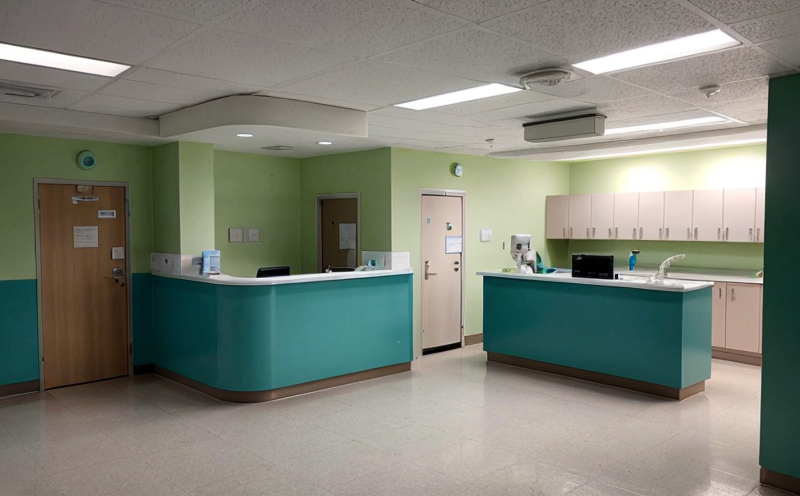USP Microbiological Examination of Non-Sterile Healthcare Products
The US Pharmacopeia (USP) [1] 1 USP is a comprehensive reference on quality standards for drug ingredients, formulations and excipients in the United States.
USP Microbiological Examination of Non-Sterile Healthcare Products is a critical standard designed to ensure that non-sterile healthcare products are free from specific pathogenic microorganisms. This service is essential for ensuring patient safety and compliance with regulatory requirements. The examination involves the identification, quantification, and control of microbial contaminants in these products.
The process begins with proper specimen collection and preparation. Samples must be handled under sterile conditions to avoid contamination. Specimens are then inoculated into appropriate media to encourage the growth of potential pathogens. This step is followed by a series of tests aimed at detecting specific microorganisms, including bacteria, fungi, and yeast.
One key aspect of this examination is the use of culture-based methods for identifying microorganisms. These methods involve incubating samples on different types of media to selectively grow various microbial groups. For instance, nutrient agar can be used for general bacterial growth, while Sabouraud dextrose agar may be suitable for fungal growth.
Once colonies have formed, they are carefully examined and identified using microscopy and biochemical tests. This identification process ensures that the correct species is isolated and reported accurately. The use of advanced analytical techniques like MALDI-TOF mass spectrometry can enhance accuracy in microbial identification.
The examination also includes sterility testing to ensure that the product does not contain any viable microorganisms capable of causing disease. Sterility tests are performed using both aerobic and anaerobic conditions, reflecting the diverse environments in which healthcare products may be used.
For fungi and yeast, specific media such as Dichloran Rose Bait (DRBC) agar or Chloramphenicol-Phenylalanine Agar (CPCA) can be employed to facilitate their growth. Once isolated, these microorganisms are identified by colony morphology, color, and other physiological characteristics.
Testing for specific pathogens is also a crucial part of this examination. This may involve the use of selective media or enrichment techniques designed to isolate particular species known to cause infections in patients. For example, Pseudomonas aeruginosa can be isolated using TSI-PAEC agar, while Staphylococcus aureus is often identified on Baird-Parker agar.
The results of these tests are meticulously recorded and reported according to USP guidelines. Compliance with these standards ensures that healthcare products meet the highest quality benchmarks set forth by regulatory bodies. This process not only enhances patient safety but also builds trust in the pharmaceutical industry.
Why It Matters
The importance of USP Microbiological Examination cannot be overstated, especially for non-sterile healthcare products. These products are used in various medical procedures and can come into contact with patients' skin or mucous membranes, increasing the risk of contamination.
Contamination from microorganisms such as bacteria, fungi, and yeast can lead to serious infections, particularly among immunocompromised individuals or those receiving treatments that compromise their immune systems. Ensuring that these products are free from harmful pathogens is essential for maintaining patient safety and preventing adverse events.
The examination also plays a vital role in the development and quality control of healthcare products. By identifying and controlling microbial contaminants, manufacturers can improve product consistency and reliability. This not only enhances the effectiveness of the products but also reduces the risk of recalls or withdrawals due to contamination issues.
Regulatory compliance is another critical aspect. Many countries have stringent regulations governing the safety and quality of healthcare products. Compliance with USP ensures that products meet international standards, facilitating easier market access and broader acceptance in different regions.
The examination also supports the ethical responsibility of pharmaceutical companies. By ensuring their products are free from harmful microorganisms, they uphold a commitment to public health and safety. This aligns with the principles of good manufacturing practices (GMP) and promotes a culture of quality assurance throughout the industry.
International Acceptance and Recognition
The USP Microbiological Examination is widely recognized and accepted internationally, particularly in countries that align their regulatory frameworks with those of the United States. The USP standards are harmonized with international guidelines such as ISO 14971:2007 on medical device risk management, which emphasizes the importance of microbial contamination control.
Many European countries follow EU directives and recommendations regarding microbiological examination in healthcare products. The European Pharmacopoeia (EP) [2] 2 The European Pharmacopoeia is the legal standard for medicines in Europe.
The EP often references USP standards, acknowledging their robustness and reliability. Similarly, other regulatory bodies like the World Health Organization (WHO) and International Conference on Harmonization (ICH) recognize the importance of microbial examination.
Recognition from these international bodies ensures that products meeting USP standards can be easily exported and used in various global markets. This interoperability fosters a harmonized approach to quality assurance, reducing barriers to trade and enhancing patient safety across borders.
Use Cases and Application Examples
The USP Microbiological Examination is applicable to a wide range of healthcare products that are not sterile. These include medical devices, creams, lotions, and other topical applications used in healthcare settings. Here are some specific use cases:
Cosmetics: Non-sterile cosmetics like face masks, body lotions, and hair care products need to be free from harmful microorganisms to ensure they do not cause infections or allergic reactions.
Medical Devices: Items such as catheters, wound dressings, and surgical instruments that come into direct contact with the skin require thorough microbiological examination. This helps prevent post-operative infections and other complications.
Liquid Preparations: Medicinal solutions like syrups, suspensions, and eye drops are susceptible to microbial contamination due to their liquid form. USP ensures these formulations remain safe for patient use.
Oral Care Products: Toothpaste, mouthwashes, and other oral hygiene products need to be free from harmful microorganisms to prevent the spread of infections through saliva or dental procedures.
In each case, thorough examination using USP ensures that these products meet stringent quality standards. This not only protects patients but also enhances the reputation of healthcare providers who use such products.





